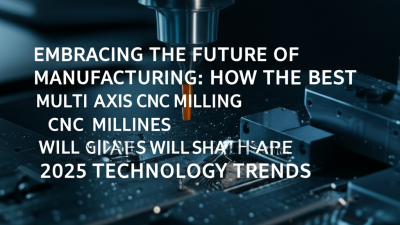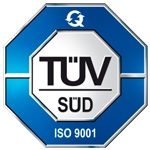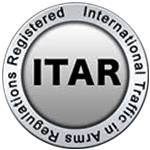Embracing the Future of Manufacturing How the Best Multi Axis CNC Milling Machines will Shape 2025 Technology Trends
As we look towards 2025, the manufacturing landscape is poised for a transformative shift driven by advancements in technology, particularly the rise of the Multi Axis CNC Milling Machine. According to a recent report by MarketsandMarkets, the CNC machine market is projected to reach $100.8 billion by 2026, growing at a CAGR of 6.6%. This surge is largely attributed to the increasing demand for precision engineering and automation across various sectors. Multi Axis CNC Milling Machines, with their ability to perform complex machining tasks in a single setup, are not only enhancing productivity and efficiency but also enabling manufacturers to innovate designs previously deemed impossible. In this blog, we will explore the pivotal trends and strategies that will define the future of manufacturing and how harnessing the full potential of Multi Axis CNC Milling Machines will be crucial in staying competitive in this rapidly evolving industry.

The Evolution of Multi-Axis CNC Milling: Past to Present Innovations
The evolution of multi-axis CNC milling technology has significantly transformed manufacturing processes over the last few decades. Historically, CNC milling machines were confined to three-axis capabilities, limiting the complexity and precision achievable in component designs. However, advancements in multi-axis machining have enabled manufacturers to improve part accuracy by up to 30%, according to a report by MarketsandMarkets. This shift has allowed for more intricate designs, reducing the need for multiple setups and minimizing production time.
In present-day production environments, the integration of automation and advanced software in multi-axis CNC machines is further enhancing operational efficiency. Reports suggest that the global CNC milling machine market is expected to reach $100 billion by 2025, driven primarily by the demand for precision manufacturing in industries such as aerospace and automotive. Multi-axis machines now offer features such as tool path optimization and predictive maintenance, contributing to reduced downtime and increased productivity. With such innovations firmly rooted in manufacturing, the future of multi-axis CNC milling promises to redefine production capabilities and meet the ever-evolving industrial demands.
Key Features of the Best Multi-Axis CNC Milling Machines in 2025
As we head into 2025, the landscape of manufacturing is being dramatically shaped by advances in multi-axis CNC milling machines. These machines are becoming indispensable tools for precision engineering, offering capabilities that traditional machining methods cannot match. Key features to look for in the best multi-axis CNC milling machines in 2025 include enhanced spindle speeds, improved torque, and greater tool flexibility. These features allow for more complex geometries and intricate designs, enabling manufacturers to push the boundaries of innovation.
Tip: When selecting a multi-axis CNC milling machine, consider the ease of programming and the compatibility with the software you plan to use. Machines equipped with intuitive interfaces can significantly reduce setup times and improve overall productivity.
Another critical feature is automation integration. The ability to seamlessly incorporate robotic arms and automated loading systems will not only enhance efficiency but will also help in reducing labor costs. As manufacturers strive for lean production methods, these innovations are set to become standard in the industry.
Tip: Invest in training for your personnel to maximize the benefits of automation in your CNC operations. A skilled workforce can adapt to new technologies and fully leverage the capabilities of advanced machining systems, ensuring a competitive edge in the market.
Impact of Automation on Multi-Axis CNC Milling Efficiency and Precision
The rise of automation in multi-axis CNC milling is revolutionizing the manufacturing landscape, significantly enhancing efficiency and precision. Automated features such as tool changers, adaptive machining, and real-time monitoring systems minimize human error and optimize workflow. This not only accelerates production times but also ensures consistent quality, serving industries that demand rigorous standards such as aerospace, automotive, and medical device manufacturing.
As we move towards 2025, it's essential to recognize that the integration of advanced technologies like artificial intelligence and machine learning into CNC milling machines will further elevate their capabilities. By harnessing data analytics, manufacturers can predict maintenance needs, adjust machining parameters on-the-fly, and enhance decision-making processes. This evolution towards smart manufacturing will create a seamless interface between machines and operators, fostering a new era of collaborative robotics that work alongside human workers to maximize productivity while ensuring high precision in complex tasks.
Embracing the Future of Manufacturing: How the Best Multi Axis CNC Milling Machines will Shape 2025 Technology Trends
| Feature | 2023 Standard | Projected 2025 Standard | Impact on Efficiency (%) | Impact on Precision (%) |
|---|---|---|---|---|
| Automation Integration | Basic | Advanced | 20 | 15 |
| Cutting Speed (m/min) | 50 | 75 | 30 | 10 |
| Tool Change Time (sec) | 15 | 5 | 50 | 25 |
| Precision (μm) | 25 | 10 | 10 | 20 |
| Energy Consumption (kWh) | 100 | 70 | 30 | 15 |
Emerging Materials and Techniques in Future CNC Milling Technology
The landscape of CNC milling technology is evolving rapidly, driven by emerging materials and innovative techniques that promise to revolutionize manufacturing by 2025. Advanced materials such as carbon fiber composites and high-performance alloys are becoming increasingly prevalent in CNC applications, enabling manufacturers to produce lighter and stronger components. According to a report by MarketsandMarkets, the global composite materials market is projected to reach $146.99 billion by 2025, indicating a significant shift toward lightweight materials that improve efficiency and performance in manufacturing processes.
Techniques in CNC milling are also advancing, with the integration of artificial intelligence and machine learning optimizing machining operations. These technologies enhance precision and reduce waste, ultimately leading to cost savings and improved product quality. A study by Gartner predicts that 50% of manufacturing firms will utilize AI-driven automation in their processes by 2025.
**Tip:** To stay competitive, manufacturers should consider investing in training programs that focus on these emerging materials and techniques. Staying up-to-date with technology trends will not only enhance skill sets but also promote innovation within the organization.
**Tip:** Another valuable strategy is to establish partnerships with material suppliers and technological innovators. Collaborating with industry leaders can accelerate the adoption of new materials and techniques, ensuring that companies remain at the forefront of CNC milling advancements.
Emerging Trends in Multi-Axis CNC Milling Machines (2025)
How AI and IoT Will Transform Multi-Axis CNC Milling Operations by 2025
The future of multi-axis CNC milling operations is poised for a transformative shift, driven primarily by advancements in artificial intelligence (AI) and the Internet of Things (IoT). By 2025, we can expect these technologies to revolutionize traditional manufacturing processes, making them smarter, more efficient, and increasingly interconnected. AI algorithms will enable predictive maintenance, reducing downtime by anticipating equipment failures before they occur. This proactive approach not only minimizes costs but also maximizes productivity, allowing manufacturers to maintain a steady output pace in an ever-competitive landscape.
Meanwhile, the integration of IoT in multi-axis CNC systems will facilitate real-time data exchange between machines, tools, and operators. This connectivity ensures that every component of the manufacturing process is monitored and can be adjusted on-the-fly, enhancing precision and quality control. Additionally, with a vast amount of data being collected, manufacturers will gain deeper insights into operational efficiency, leading to continuous improvements and innovation. The relentless march towards a fully automated and data-driven production environment is poised to redefine the benchmarks of success in manufacturing by 2025.
NORTH EASTON MACHINE • 218 Elm Street • North Easton, MA 02356 • 508-238-6219

